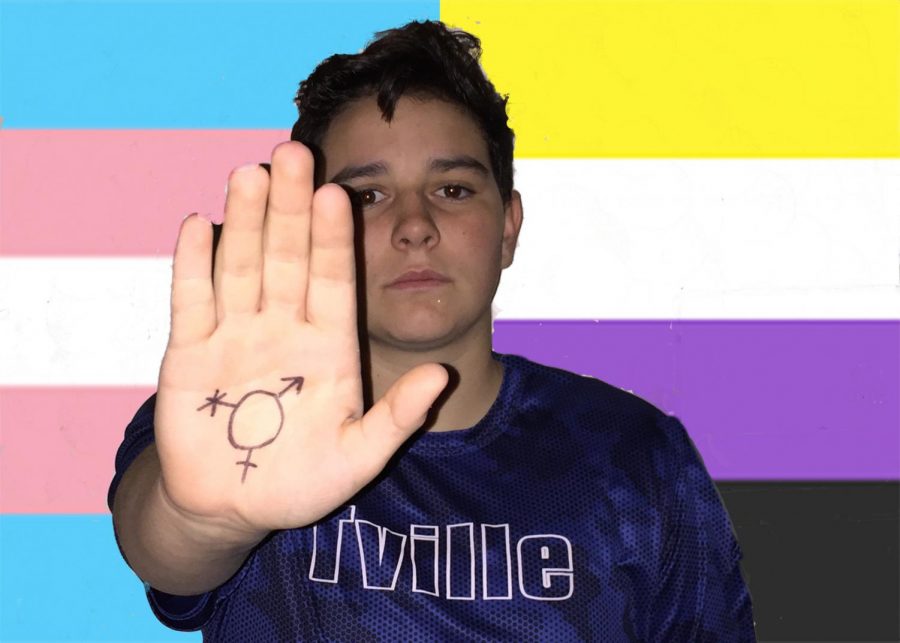Transgender and non-binary students search for school support
Non-binary Student Jordan Harvey poses with gender marker, indicative of how they don’t fit within the ‘standard’ gender identities.
October 2, 2018
With the recent resurgence of the importance of gender identity, many non-binary, transgender and gender-expansive youth and faculty are searching for some kind of guidance on pronoun use, treatment and support from the school district on where they stand within school policies.
According to the most recent Gay Lesbian Straight Education Network Report (GLSEN), last published in 2016 and following all fifty states, 75 percent of transgender students feel unsafe at school because of the way in which they expressed their gender, while an additional 61 percent of genderqueer or gender non-conforming students felt unsafe at school.
“Coming out at all, there is always a moment of hesitation where you see someone, you meet someone and they’re really nice, but again, you don’t know anything about them,” said Jordan Harvey, a non-binary Senior. “It’s just a moment that lasts forever about whether or not you could or couldn’t come out to them. It’s super scary.”
Within the Granite School District, there are no policies or instruction currently enforced, other than nationally provided literature such as Title XI which prohibits discrimination on the basis of gender. This policy protects the transgender and non-binary students from retaliation if they use resources that are congruent to their gender identity.
A large concern within the LGBTQ+ community is the lack of a more publicly accessible gender-neutral bathrooms. which erases the necessity for students or faculty to deliberate between the debilitating two options.
“When I was in middle school we had to go through a whole thing to get me to use the men’s restroom. I’m not sure what the policies are for this school, but just let kids go to their correct bathrooms without any problems,” said Ken Fuentes, a transgender student. “I’ve identified as a male since 8th grade, but I still get really intimidated and almost scared, just because I feel like people are going to dehumanize me, like ‘why is that in here?’”
The National Center for Transgender Equality released a model policy for school districts nationwide to indicate the most effective way to “to foster an educational environment that is safe, welcoming, and free from stigma and discrimination for all students, regardless of sex, sexual orientation, gender identity, or gender expression, to facilitate compliance with local, state and federal laws concerning bullying, harassment, privacy, and discrimination, and to ensure that all students have the opportunity to express themselves and live authentically.”
Concerns expressed by students regarding the lack of these policies are generally directed towards teachers, who may or may not know how to regard gender non-conforming or transgender students.
“A teacher talked to me about how they received training on how to deal with that kind of thing, but I feel as though a lot of them know it, but again, they either don’t care or they’re not sure of how to go about doing that,” said Harvey. “They don’t want to ask your pronouns, they don’t feel comfortable doing that because they feel as though they aren’t necessarily as educated on it as they want to be or could be.”
An idea proposed by many students is the formation of a GSA, or Gay-Straight Alliance, which would provide both a safe space for LGBTQ+ students and faculty while also give those who are uneducated about these issues to receive insights into the everyday struggle of LGBTQ+ students.
According to that same GLSEN report, “…Gay-Straight Alliances (GSAs) or sometimes as Queer Student Alliances or Gender and Sexuality Alliances, can provide LGBTQ students in particular with a safe and affirming space within a school environment that they may otherwise experience as hostile.”
Fuentes express his desire for students to have a safe space in which everyone can coexist and become aware of how to support and include all students, those who are both open about their gender and those who are not.
“I want to let any other trans or nonbinary students that are out there know that I am here for them; that I am out. So people know that they can be out too, that they are safe and they will always have someone to be there for them,” said Harvey.





